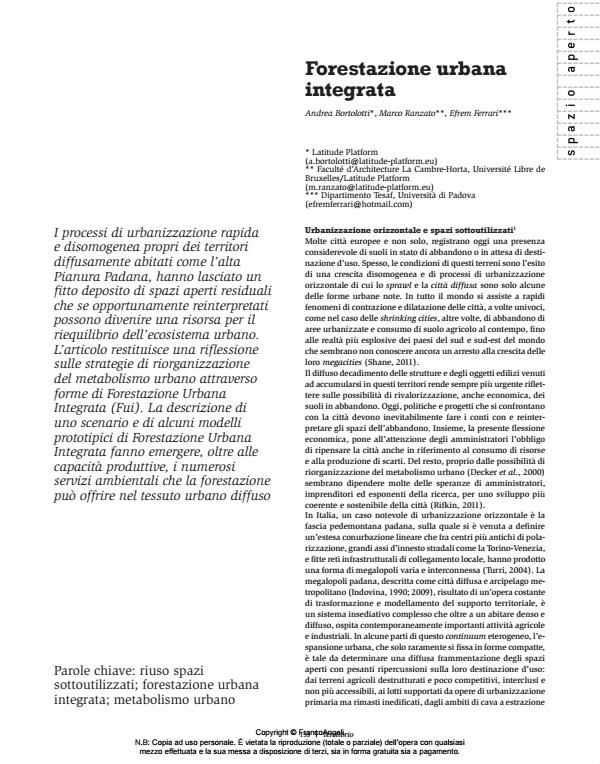Forestazione urbana integrata
Titolo Rivista TERRITORIO
Autori/Curatori Andrea Bortolotti, Marco Ranzato, Efrem Ferrari
Anno di pubblicazione 2014 Fascicolo 2013/67 Lingua Italiano
Numero pagine 9 P. 133-141 Dimensione file 2437 KB
DOI 10.3280/TR2013-067022
Il DOI è il codice a barre della proprietà intellettuale: per saperne di più
clicca qui
Qui sotto puoi vedere in anteprima la prima pagina di questo articolo.
Se questo articolo ti interessa, lo puoi acquistare (e scaricare in formato pdf) seguendo le facili indicazioni per acquistare il download credit. Acquista Download Credits per scaricare questo Articolo in formato PDF

FrancoAngeli è membro della Publishers International Linking Association, Inc (PILA)associazione indipendente e non profit per facilitare (attraverso i servizi tecnologici implementati da CrossRef.org) l’accesso degli studiosi ai contenuti digitali nelle pubblicazioni professionali e scientifiche
The processes of rapid and uneven urbanisation found in the diffusely inhabited areas of the Upper Po Plain have left a dense deposit of residual outdoor spaces, which if reinterpreted appropriately could become a resource to restore balance to the urban ecosystem. The paper discusses strategies for the reorganisation of urban metabolism by means of forms of integrated urban forestation (Fui). The description of a scenario and of some prototype models of integrated urban forestation highlights not only the production capacities but also the numerous environmental services which forestation can offer in a diffuse urban area.;
Keywords:Reuse of underused spaces; integrated urban forestation; urban metabolism
- Anguillari E., 2010, «Alla ricerca di un paesaggio energetico-ecologico, in Tosi M.C., Anguillari E., Bonini Lessing E., Musco F., Ranzato M., Paesaggi deltizi e territori fragili. Comparazioni, Iuav, Venezia, pp. 93-104.
- Decker E., Elliot S., Smith F., Blake D., Rowland F. S., 2000, «Energy and Material Flow through the Urban Ecosystem», Annual Review of Energy and the Environment, vol. 25, pp. 685-740, DOI: 10.1146/annurev.energy.25.1.685
- Eea, 2013, EU Bioenergy Potential from a Resource Efficiency Perspective, Report n. 6.
- Fabian L., Giannotti E., Viganò P., 2012, Recycling City. Lifecycles, Embodied Energy, Inclusion, Giavedoni, Pordenone.
- Gregotti V., 1966, Il territorio dell’architettura, Feltrinelli, Milano.
- Indovina F., 1990, La città diffusa, Iuav-Daest, Venezia.
- Indovina F., 2009, Dalla città diffusa all’arcipelago metropolitano, FrancoAngeli, Milano.
- Intergovernmental Panel on Climate Change (Ipcc), 2007, Fourth Assessment Report: Climate Change, Geneva.
- Lanzani A., Longo A., Novak C, Zanfi F., Gambino D,, Moro A, Garda
- E., Morello E., Bortolotti A., Alì A., Valtorta L. e Motta F., 2011, Dopo la crescita. La riforma degli spazi aperti e delle aree produttive della provincia di Monza e Brianza, Rapporto finale sul documento di inquadramento del Piano d’Area Pedemontana.
- Lanzani A., 2011, In cammino nel paesaggio. Questioni di urbanistica e di geografia, Carocci, Roma.
- Lanzani A. e Pasqui G., 2011, L’Italia al futuro, FrancoAngeli, Milano.
- Magnaghi A., 2000, Il progetto locale, Bollati Boringhieri, Torino.
- Millennium Ecosystem Assessment (MA), 2005, Ecosystems and Human Well-being: Current State and Trends, Island Press, Washington D.C.
- Paoletti E., 2009, «Ozone and urban forest in Italy», Environmental Pollution, vol. 157, pp. 1506-1512, DOI: 10.1016/j.envpol.2008.09.019
- Plante S., MacQueen M., 2011, A Review of Current Research Relating to Domestic Building Subsidence in the UK: What Price Tree Retention?, in «Research Report», n. 017, Forestry Commission, UK, pp. 219-227.
- Price C., 2003, «Quantifying the Aesthetic Benefits of Urban Forestry», Urban Forest & Urban Green, vol. 1, pp. 123-133.
- Rifkin J., 2011, La terza rivoluzione industriale, Mondadori, Milano.
- Scolozzi R., Morri E., Santolini R., 2012, «Pianificare territori sostenibili e resilienti: la prospettiva dei servizi ecosistemici», Territorio, n. 60, pp. 164-175, DOI: 10.3280/TR2012-060027
- Secco L., Pettenella D., Gatto P., 2010, «Forestry Governance and Collective Learning Process in Italy: Likelihood or Utopia?», Forest Policy and Economics, vol. 13, pp. 104-112, DOI: 10.1016/j.forpol.2010.04.002
- Shane D.G., 2011, Urban Design Since 1945: A Global Perpective, Wiley, London.
- Stremke S., 2010, Designing Sustainable Energy Landscapes, Concepts Principles and Procedures, Thesis (Ph.D.), Wageningen University, Wageningen, Netherlands.
- Tjallingii S.P., 1996, Ecological Conditions. Strategies and Structures in Environmental Planning, Thesis (Ph.D.), Delft University of Technology, Delft, Netherlands.
- Turri E., 2004, La megalopoli padana, Marsilio, Venezia.
- Tzoulas K., Korpela K., Venn S, Yli-Pelkonen Y, Ka´zmierczak A., Niemela J., James P., 2007, «Promoting Ecosystem and Human Health in Urban Areas Using Green Infrastructure: A Literature Review», Landscape and Urban Planning, vol. 81, n. 3, pp. 167-178, DOI: 10.1016/j.landurbplan.2007.02.001
- Ulisse A., 2010, Energicity. An Experimental Process a New Energy Scenarios. Pescara Architecture and Public Spaces, Babel, Trento.
Andrea Bortolotti, Marco Ranzato, Efrem Ferrari, Forestazione urbana integrata in "TERRITORIO" 67/2013, pp 133-141, DOI: 10.3280/TR2013-067022